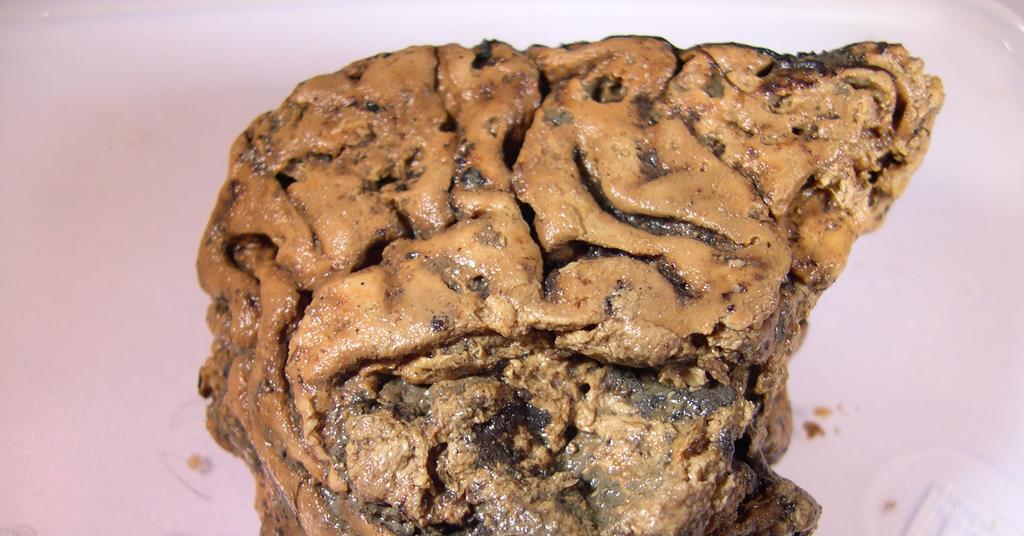Oxford University’s Alexandra Morton-Hayward spends her days immersed in the study of brains—quite literally.
The former undertaker turned scientist is dedicated to unraveling the mystery of why certain human brains remain remarkably well-preserved after death, sometimes for millennia, even as all other soft tissues decay.
And for anyone visiting her workplace, it’s wise not to expect to find a snack.
As Morton-Hayward humorously puts it, “We do have four and a half fridges, so you’d think they might be in with a good chance of a meal. But no, they are stuffed to the brim with preserved ancient brains.”
Morton-Hayward, a postgraduate researcher in the university’s earth sciences department, recently co-authored a study on this phenomenon, published in this week’s issue of the journal Proceedings of the Royal Society B: Biological Sciences.
‘Just a brain rattling around in a skull’
In forensic science, it’s commonly believed that during decomposition, the brain is the first organ to degrade, Morton-Hayward explains. However, she notes that sometimes the opposite occurs.
Together with her colleagues, she has documented 4,400 cases worldwide dating back to the 1600s where preserved human brains have been found.
While many of these cases can be reasonably explained—either through intentional preservation in death rituals or natural environmental factors—a third of them, approximately 1,300 cases, remain entirely mysterious.
“These are what we call the unknown preservation types. They consist of the only soft tissue remaining among otherwise skeletonized remains,” Morton-Hayward elaborates. “So, just a brain rattling around in a skull.”
Morton-Hayward mentions that these preserved brains, such as the 18th-century specimen excavated from the First Baptist Church of Philadelphia, typically appear shrunken and display hues of reddish-orange.
The oldest brain specimen she has encountered dates back 12,000 years, and they have been discovered in diverse locations around the globe.
“They are found in the most intriguing sites,” she says.
“We have your regular cemetery burials, but we also have Korean tombs, sunken shipwrecks, individuals dressed in otter skins and buried in tree-log coffins, clay burials in Japan, and even in swamps in Florida—just a wide array of different environments.”

Despite their diverse origins, these brains share common characteristics. They often exhibit vivid colors like bright red, orange, or yellow, earning them a “rusty” appearance, as Morton-Hayward describes.
Remarkably well-preserved, these brains are typically shrunken in size, fitting neatly into the palm of one’s hand, resembling a large walnut.
The question remains: What prevents these brains from disintegrating when all other soft tissues have decayed?
“It’s quite unusual, but the fact that they preserve without any other soft tissue suggests a preservation mechanism unique to the nervous system,” Morton-Hayward posits.
She emphasizes the need to investigate what biochemical properties of the nervous system during life might influence its decay postmortem.
“The nervous system has a unique ratio of lipids—fatty compounds—and proteins—complex molecules within cells,” Morton-Hayward explains.
“These proteins and lipids are specific types that are more prevalent in the brain than in any other organ. Over time, they can bind together, especially in the presence of metals like iron, which naturally accumulate in the brain with age.”
According to her, this process may generate molecules that enable brain tissue to endure over long periods.
Interestingly, this preservation mechanism bears similarities to what occurs in brains affected by dementia.
“When I began studying ancient brains, I never imagined it might have practical medical applications. But perhaps it could help us understand brain aging and health,” she suggests optimistically.
“It might shed light on ancient diseases, health status, diet, and various other aspects through the recovery of these ancient biomolecules—proteins and lipids—from these brains.”
Howard Williams, an archaeologist at the University of Chester in the U.K., who was not involved in the study, echoes these sentiments.
“It underscores the untapped potential for further analysis of human brains from archaeological contexts,” he remarks to CBC.
Williams also raises ethical considerations, suggesting that this research may complicate discussions about the repatriation and reburial of remains, particularly those of Indigenous peoples.
He also speculates on the number of preserved brains that may have been overlooked or discarded at archaeological sites over the years.
“I fear that the thousands of brains studied so far may only represent a fraction of what we could learn if people had recognized earlier the potential of these soft tissue human remains,” he concludes.
